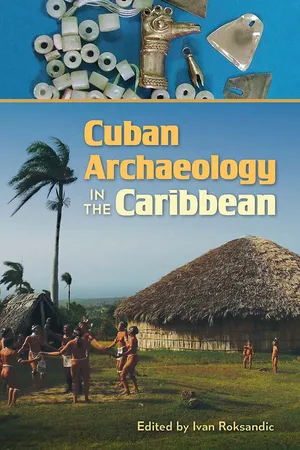
- 305 pages
- English
- PDF
- Available on iOS & Android
Cuban Archaeology in the Caribbean
About this book
As the largest--and most centrally located--island of the Caribbean, Cuba has seen successive waves of migration to its shores. Its early colonization, and that of the Greater Antilles, is complicated by population movements within the Circum-Caribbean. In this volume, Ivan Roksandic and an international team of researchers present a new theory of mainland migration into the Caribbean.
Through analysis of early agriculture, burial customs, dental modification, pottery production, and dietary patterns, the contributors enable a very close look at the lifeways and challenges of the native populations. They decipher patterns of movement between the islands and present-day Mexico and Central America and explore the interactions between the islands' inhabitants, including the fate of indigenous groups after European contact. Together the essays produce a view of the early Caribbean that is rich with dynamic networks of exchange and matrixes of cultural influences, more intricate and multilinear than previously believed.
With contributions from archaeology, physical anthropology, environmental archaeology, paleobotany, linguistics, and ethnohistory, this volume adds to ongoing debates concerning migration and colonization. It examines the importance of landscape and seascape in shaping human experience; the role that contact and interaction between different groups play in building identity; and the contribution of native groups to the biological and cultural identity of postcontact and modern societies.
Ivan Roksandic, assistant professor in the Department of Anthropology and coordinator of the Interdisciplinary Linguistics Program at the University of Winnipeg, is the author of The Ouroboros Seizes Its Tale: Strategies of Mythopoeia in Narrative Fiction. A volume in the Florida Museum of Natural History: Ripley P. Bullen SeriesFrequently asked questions
- Essential is ideal for learners and professionals who enjoy exploring a wide range of subjects. Access the Essential Library with 800,000+ trusted titles and best-sellers across business, personal growth, and the humanities. Includes unlimited reading time and Standard Read Aloud voice.
- Complete: Perfect for advanced learners and researchers needing full, unrestricted access. Unlock 1.4M+ books across hundreds of subjects, including academic and specialized titles. The Complete Plan also includes advanced features like Premium Read Aloud and Research Assistant.
Please note we cannot support devices running on iOS 13 and Android 7 or earlier. Learn more about using the app.
Information
Table of contents
- Cover
- Cuban Archaeology in the Caribbean
- Title
- Copyright
- Contents
- List of Figures
- List of Tables
- Introduction: Cuba and the Greater Antilles
- 1. The Role of the Nicaraguan Rise in the Early Peopling of the Greater Antilles
- 2. An Archaeological Overview of the Caribbean Coast of Nicaragua
- 3. People and Plants in the Precontact Caribbean: The View from Canímar Abajo, Cuba
- 4. Diagnosis of the Processing Methods of Starch-Rich Foods in Archaeological Artifacts: An Experimental Model
- 5. Sedentism and Mobility Patterns at Canímar Abajo Cemetery, Matanzas, Cuba: Paleodemographic Evidence
- 6. Communities in Contact: Health and Paleodemography at El Chorro de Maíta, Cuba
- 7. A Pre-Columbian Dental Modification Complex at the Site of Canímar Abajo, Matanzas, Cuba
- 8. Isotopic Evidence of Variations in Subsistence Strategies and Food Consumption Patterns among “Fisher-Gatherer” Populations of Western Cuba
- 9. Human Mobility and Dietary Patterns in Precolonial Puerto Rico: Integrating Multiple Isotope Data
- 10. Food Preparation and Dietary Preferences among the Arawak Aboriginal Communities of Cuba
- 11. Indians in Cuba: From Pre-Columbian Villages to the Colonial World
- 12. Los Indios de Campeche: The Maya Diaspora and the Mesoamerican Presence in Colonial Cuba
- 13. Recent Advances in the Archaeology of the Greater Antilles: Some Final Remarks
- References
- List of Contributors
- Index